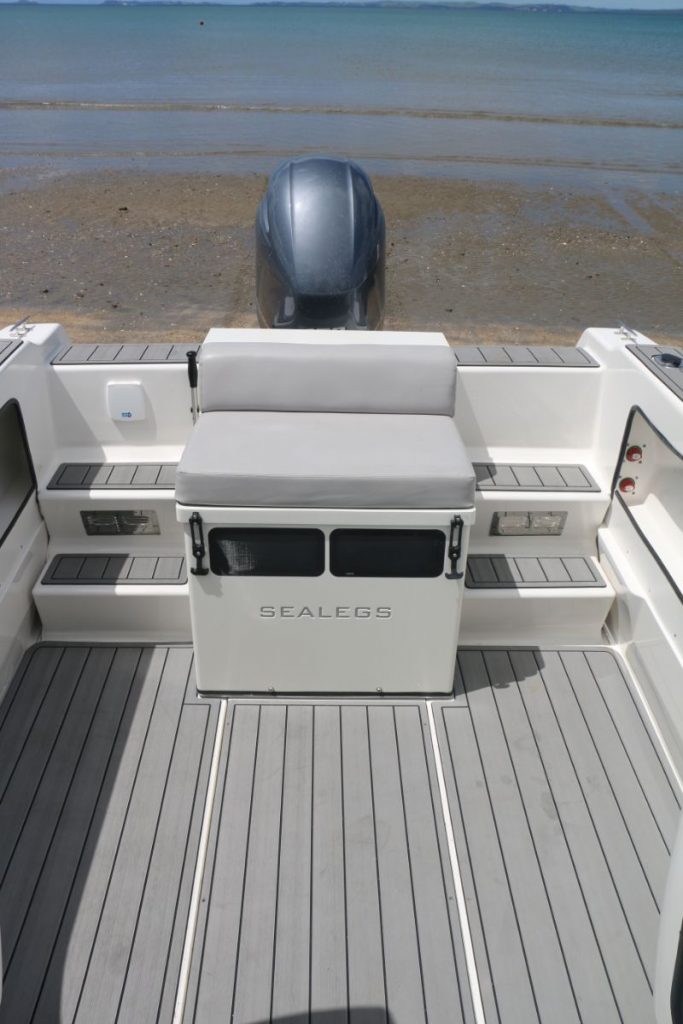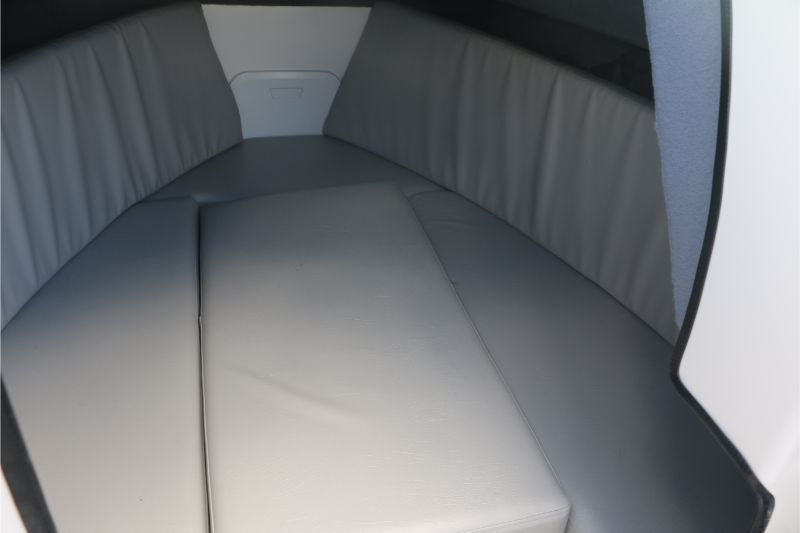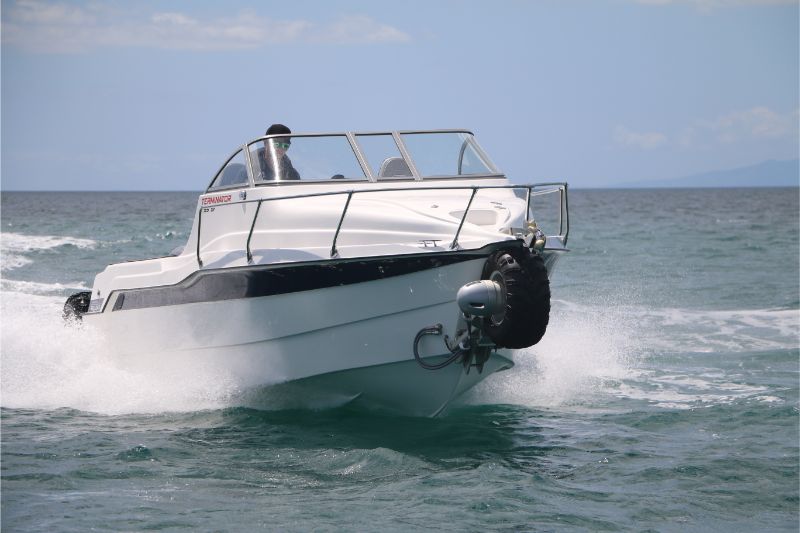Anyone who attended the recent Auckland On Water Boat Show would no doubt have wandered through the Sealegs stand and would have noticed the first all fibreglass (GRP) model for the company. Resisting the urge to use Schwarzenegger puns (well maybe a few), Freddy Foote checks out the Terminator 755 SF.
The Terminator 755 SF was developed by Terminator Boats in conjunction with its parent company Brazen Composites, in Malaysia. Sealegs are partnering the Malaysian company and supplying them with ‘System 60’ which is the wheels and hydraulics package that is Sealegs or what they call the Amphibious Enablement System (AES). Brazen Composites doing the R&D work to couple the ‘System 60’ to one of it’s current model moulds.
This latest addition to the expanding amphibious product range demonstrates the on-going efforts and success of the Sealegs AES Strategy previously seen in craft released by Stabicraft Marine and ASIS Boats in Dubai.
Sealegs says they plan to continue the strategy of developing amphibious craft through offering amphibious systems to global boat manufacturers to widen their product range and reach of customers.

Brazen Composites and its subsidiary Terminator Boats, have a long history in building composite craft. The Terminator 755 is the first 100% fibreglass model released with Sealegs that does not feature the Hypalon or aluminium pontoons previously seen in the rest of the Sealegs range.
“With every new partner we appoint under the AES strategy, our systems and processes improve to better accommodate the needs of a wider range of boat manufactures,” says Sealegs CEO, David McKee Wright.
“The Terminator 755 demonstrates the ability to leverage the expertise of alternative boat manufacturers, as we benefitted from the skills of our partner, Brazen Composites, to release the all-fiberglass boat. A skillset where Sealegs has limited experience.”
“By leveraging the efficient manufacturing base in Malaysia, and the lower cost manufacturing process of fibreglass, we have been able to introduce an introductory price that is better than any other in the Sealegs range,” adds McKee Wright.

For Kiwi Boaties
By all accounts, the arrival of the new Terminator SF has been driven by customer demand for a fibreglass cabin boat, with a healthy cockpit and the ability to traverse onto land.
This model we tested was the prototype and has been sold. Sealegs also confirming they have sold a further three. The layout is fairly traditional for a cabin boat. There is a large forward cabin with an upholstered vee berth, complete with infill, side shelf storage as well as space under the berths.
The helm is neat and tidy and is a one piece mould that continues over to the port side. Mounted into the dash is a Lowrance HDS 9” MFD, while below is the steering wheel, engine instruments and the controls for the Sealegs system. To the right is the throttle for the outboard, as well as the speed control for the Sealegs behind that.
A large curved windscreen keeps you well protected from the wind, and there’s a grab rail for the port side passenger, plus side shelf storage.


Seating was made up of some rather high-backed single pedestal seats which contain shock mitigating foam. These I’m told are being ditched on future boats in favour of a more traditional king/queen style seating arrangement, that will provide more storage or pedestal seats if requested.
The cockpit is open and spacious and is finished with Ultralon throughout. This a extremely tough, soft to walk on and gives the boat a stylish look. Alternatively, you can specify real Teak.
Deep side shelves run the length of both sides of the cockpit and are finished with two-rod holders in each coaming. In the centre of the transom sits the Honda power pack, which can be accessed by lifting up the hatch above. Either side are steps that provide access to the transom area. Though I felt this space could have been better utilised by adding port corner seats.
No dive ladder in the port corners as this would be impacted by the rear wheels, so an over the side boarding ladder can be specified.
I’ll Be Back
Talking with the Sealegs sales team during our test day, I was quite surprised to find out that only around 5% of Sealegs craft sold are specified with a trailer.
“Many of our customers own coastal property where they have their own access to the water or are not far from the water. Most just like to load up the boat in their front yard or shed, drive it down to the water and off they go for the day,” says Sealegs Marketing Manager, Peter Small.
What about taking the boat in for a service you may ask? Sealegs offer a pickup and drop-off service for the boats which sees the boat transported on a Sealegs specific trailer.
The Sealegs ‘System 60’, is the same on every Sealegs craft, with all the functionality the same as well. The system sees powerful motorised wheels, one at the front and two at the rear giving the Terminator 755 a variable speed of 0-7km/h (forward and reverse). Power is a 22hp Honda driven hydraulic power pack.
When you drive the boat into the water, the wheels are quickly retracted into the ‘Up’ position and are completely out of the water. The boat is then driven and used as normal. When approaching land, the Sealegs wheels are lowered into the ‘Down’ position while still moving in the water.
I’ve driven a number of Sealegs boats in the past, and once you get your head around all the procedures, and knowing when to engage your outboard motor and disengage your wheels, it’s a piece of cake.


Our test boat was powered by a Yamaha 150hp 4S outboard and it performed well. Any Sealegs craft isn’t a light boat, with a lot of extra weight distributed throughout the boat. The forward wheel and hydraulics, the Honda engine centre, and the two rear wheels aft for example. This one, being made of Fibreglass will be slightly heavier than a similar sized aluminium constructed boat.

Let of Some Steam
We achieved a top speed of 34.0 knots @ 5400rpm, using 62lph and achieved a cruise speed of 21 knots at 4000rpm using 25.3lph. If you wanted a little more performance, then the hull can certainly handle it, and it can be fitted with outboards up to 200hp.
On our test day in the waters off Browns Bay on Auckland’s North Shore, we experienced some reasonably choppy conditions, and the boat performed well.
The Terminator hull feels solid in the water and punched through the chop quite easily. It responded to trim well, and the engine had enough power with a full load of fuel and three of us onboard.
The driving position at the helm wasn’t the most comfortable. The seats are too close to the helm itself, and because the Sealegs controls are fitted just to the right of the steering wheel, the helming position is off centre by about 200mm. However, this is easily remedied with a change to the helm seat such as the new king/queen’s which will be standard in future models.
Overall, the boating public asked and Sealegs delivered, and with four boats sold since the prototype arrived on our shores in late September, it certainly proves that they got what they wanted.

Specifications
- Model & Model: Terminator 755 SF
- Price as tested: $NZ185,357
- Type: Cabin Boat
- Construction: GRP
- LOA: 7.55m (wheels up)
- Beam: 2.25m
- Deadrise: 20 degree
- Dry weight: 1730kg
- Test Power: 150hp Yamaha 4S
- Propeller: 17” Reliance
- Power options: Outboard Only
- HP Range: 150-200hp
- Fuel capacity: 170L
- Contact: sealegs.com
|
RPM |
Knots |
L/h |
|
1000 |
4.0 |
3.4 |
|
1500 |
5.3 |
5.3 |
|
2000 |
6.1 |
7.1 |
|
2500 |
7.4 |
12.9 |
|
3000 |
9.3 |
16.7 |
|
3500 |
14.5 |
24.5 |
|
4000 |
21.0 |
25.3 |
|
4500 |
26.0 |
34.5 |
|
5000 |
30.0 |
46.0 |
|
5400 |
34.0 |
62.0 |




